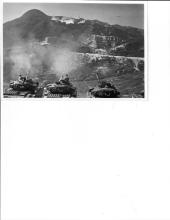Jewish Historical Society of Hong Kong
Primary tabs
Submitted by David on Wed, 2010-10-06 17:28
Here are some key points from this introduction:
- With the help of the librarian, Brenda Yi, the Judaica library in the Jewish Community Centre is home to an impressive collection of books, periodicals and related material.
- All three hundred gravestones [of the Jewish Cemetery in Happy Valley] have been meticulously recorded, photographed and translated and this information is in the process of being digitized.
- Also available in the library, having been recorded by the JHS, is the current series of interviews being conducted by the JHS and dubbed the Fireside Chats. These were initiated in a bid to record for posterity the personal experiences and family histories of some of the long-term members of the Hong Kong Jewish community.
The article doesn't give any speific contact information for the society, but here's the website for the Jewish Community Centre.


Comments
More about the Judaica Library
is available at: https://ojs.lib.byu.edu/spc/index.php/JEAL/article/view/32664/30800
Here's an extract:
PL: As you mentioned earlier, the role of this Library is to support the information needs amongst the Jewish community in Hong Kong. So can you tell me what kind of reference enquiries do you usually receive from the users of this Library? What would be a typical reference question for this Library?
BY: The reference questions that I receive can broadly be divided into two categories. One is simple questions. People ask for a particular book, or books by a certain author. They also seek recommendations on a certain subject. On the lighter side, I receive enquiries from visitors on information on transportation and sight‐seeing spots.
The other category is in‐depth research questions. The most‐asked topic of course is the local Jewish community: how and when they came, where they came from, what their life was like. This Judaic Library is the only place to answer these questions, and we collect all the information on our community in all formats as far as we can.
On a wider scope, researchers would ask for information on Jewish settlements in big cities in China, like Kaifeng, Shanghai, Harbin, and Tianjin. The Jewish community in Kaifeng has always been a very popular research topic because this is where the first Jews settled in China in the Zhou Dynasty of the Five Dynasties Period (951‐960 A.D.). The Kaifeng Jews came from Central Asia along the Silk Road as small businessmen.
Some cities are also quite popular [reference inquiries]. Harbin and Tianjin are large cities in northeast China where the Russian Jews immigrated to during the World War I and the pogroms in Russia. As for Shanghai, it was an open seaport during the Holocaust, when the Nazis tried to persecute all the Jews in Europe. There were not too many countries that would issue visa for Jews to enter. China was one of the few exceptions. As a result, thousands of Jews fled Europe and entered China via the seaport in Shanghai. A lot of Jewish people from different countries come and tell us that they went back to Shanghai to visit the places where they lived during the World War II as refugees, or to see if their old houses were still standing. Sometimes they pass through Hong Kong. We can often read this kind of stories in newspapers or journals. It is no surprise to hear them say, “Wow, this is the house we used to live in, and there are still people living there! And the current [Chinese] occupants seem to be doing well; and we used to have a table here; and the bed was here and…” So there are numerous stories of happy reunions amongst the Jews: stories about their nostalgic old days; or fond memories that they still cling to.
Researchers come to this Library because they know that we have a Sino‐Judaic Collection which collects all sorts of information on the Jewish communities in Hong Kong, in Mainland China, and in the neighbouring countries in Southeast Asia This collection is still growing and expanding and will continue to serve people who need the information therein.
PL: For people who are making these kinds of research questions or enquiries, are they mostly academics, professors, researchers or university students? Are they usually local or overseas?
BY: The users include all of the above. I have also journalists, historians and students, some local, some overseas. The extent of the research depends on the requirements of their assignments. Some people engaging in bigger projects come to the Library in person to consult the materials, while others may ask for information by email.
I can give you some examples on how people use our resources and what their products are. Once a secondary school teacher and a few students came and looked for information on the history of the local Jewish community. They also interviewed some leaders in the community. The product was a multi‐media project to enter a competition on cultural heritage among schools. Another one was two teenage sons of a librarian friend of mine who needed more in‐depth information on Judaism than their own library could provide. They were studying in the U.K. and needed the information for their assignments. So while they were in town for vacation, they consulted the materials here.
New JHS HK Website
The website for the Jewish Historical Society of Hong Kong is now up and running. You can find it at www.jhshk.org.